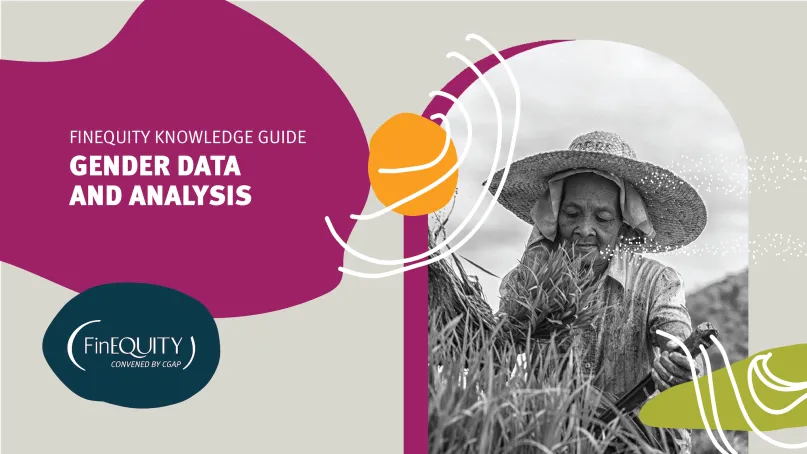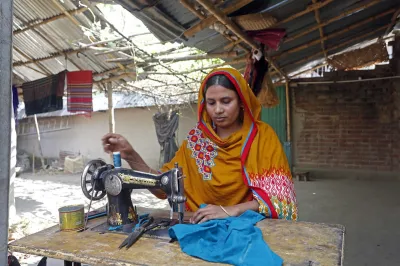FinEquity Knowledge Guide: Gender Data and Analysis

The most recent Findex data shows that the gender gap in account ownership in emerging markets narrowed to 6% in 2021 from 9% where it was stuck for many years. However, this does not sufficiently reflect the situation where globally women are still not given the same opportunity as men to participate in, and benefit from, economic growth.
Despite having better loan repayment rates and being more loyal customers, women are denied loans at twice the rate of men and receive smaller loan amounts that do not meet their needs. But who exactly is being excluded? Women are not a monolith, and yet if the industry cannot measure and analyze which financial products are used, and by whom, how can products be designed appropriately for women? Furthermore, without sex-disaggregated data, how can the industry understand the impact of financial inclusion interventions on women's lives?
What is Gender Data and Analysis?
Gender data or statistics adequately reflect differences and inequalities between women and men in all areas of life. Gender data that is collected and presented by sex as a primary and overall classification reflect gender issues and are based on concepts and definitions that adequately reflect the diversity of women and men in all aspects of their lives. Gender data also considers stereotypes and social and cultural factors that could induce gender bias in the data.* Gender analysis examines how and why gender constraints, such as social norms, impact financial market systems, how these constraints affect different segments of women (and men), and how to use these insights to design better financial products for women.
*Note: Sex most often is presented as male and female. However, initiatives such as Data2X highlight the continued evolution of data systems to represent all individuals who identify as male, female, and other gender identities.
What is the purpose of this guide?
Drawing on a sample of recent publications, this updated [July 2024] guide provides a starting point for understanding (i) where to start (what data is available at global, regional, national and organizational levels, and the common terms and concepts used to define the women’s market); (ii) the tools for using data and analysis to deconstruct the women’s market; (iii) gender analysis guidance for research, monitoring, and evaluation, and; (iv) how to sex-disaggregate data.
Who is this guide for and how can it be used?
This guide is for financial services providers (FSPs), regulators, policymakers, donors, researchers, and development partners who may, respectively, want to use gender data in the following ways:
- Financial services providers: to collect, analyze, and share sex-disaggregated data on market size, revenue, and profit in order to determine how they develop, market, disseminate, and measure (the impact of) products and services tailored to women’s needs.
- Regulators and policymakers: to develop, evaluate and adjust policies to make them more gender-responsive and to effectively monitor progress against targets.
- Donors, researchers, and development partners: to design, monitor, and evaluate the outcome of interventions that support women’s financial inclusion.
* This resource guide has been produced in collaboration with USAID in July 2022. It has been updated in July 2024 and will continue to be updated with new resources periodically. For even more resources on this topic, visit FinEquity's Resource Library.
Recommended Resources
Where to Start
Gender Data in Financial Inclusion
Women’s Financial Inclusion Data Dictionary
This glossary shares definitions of the most common financial inclusion indicators used by members of the Women’s Financial Inclusion Data (WFID) Partnership. It is the result of a systematic review of over 350 financial inclusion indicators in use across programs, surveys, datasets, and publications. The glossary advances data harmonization by accelerating an understanding of data sets and serves as a first step to increasing data compatibility.
Guideline Note on Sex-Disaggregated Data Report Templates
This guidance note provides guidance to regulated financial institutions - licensed and regulated by the central bank or by any other financial regulatory and supervisory institution – related to the different elements needed to complete periodic financial data reporting returns or reporting templates using a sex-disaggregated data approach.
Women’s Markets Definitions: Defining Women Account Holders and Women’s Businesses
This brief defines what is classified as a women's account or women-owned business, which is critical for tracking such data accurately and consistently. It also outlines the practical decisions that financial institutions need to make when setting Women's Markets definitions, the first step in generating high-quality gender data and tailoring propositions for women customers.
Supply-Side Gender Disaggregated Data for Advancing Financial Inclusion
While no universal set of proven good practices for collecting and using supply-side gender-disaggregated data (S-GDD) in the financial sector has been established, this paper explores how S-GDD has been collected and used, mainly by financial sector authorities but also by providers, and the challenges and opportunities associated with this work. It highlights lessons to date, identifies existing gaps, and proposes next steps for future work to unlock S-GDD’s potential to support women’s financial inclusion and economic empowerment.
Tools for FSPs: Using Data and Analysis to Deconstruct the Women’s Market
Towards Women’s Financial Inclusion: Gender Data Diagnostics of Six Countries
This set of six country diagnostics offer detailed assessments of the availability and use of gender data for achieving women’s financial inclusion, including the opportunities to intervene, close data gaps, and expand access to financial services. The accompanying synthesis brief summarizes the main findings and lessons from the diagnostics. These reports can serve as a resource for governments, financial services providers, and others interested in improving their own gender data and financial services ecosystems.
Deconstructing the Monolith: Segmentation of Women Clients
This webinar series features Financial Service Providers (FSP) that are using innovative ways to learn and respond to women's differentiated needs and preferences as a key to growing their market share and achieving business goals. FSPs share insights about their successes, failures, and lessons learned on how they were able to benefit from adopting a segmentation approach that involved better understanding the specific needs of different groups of women and designing products and services to better meet their needs, which ultimately translated into increased profitability and impact.
InBrief-The Power of Women's Markets Data: A How-To Guide
This brief is a practical guide to support financial services providers interested in beginning to sex-disaggregating data or those looking for ways to improve their gender data practices, based on the experience of Financial Alliance for Women members. It shares best practices and relevant examples within a 5-step process: Needs Assessment and Definitions Setting, Data Planning, Systems and Process Integration, Data Capture, and Data Analysis and Use.
Mainstreaming Gender KPIs Toolkit
This toolkit presents the considerable business opportunity gender Key Performance Indicators (KPIs) present to Financial Service Providers (FSPs) in their pursuit of client centricity that enables them to tap into untapped market opportunities and to better understand and serve different segments of women and men. The toolkit is available in English and Arabic.
Gender Analysis for Research, Monitoring, and Evaluation
Measuring Women’s Economic Empowerment in Financial Inclusion
This background paper documents the FinEquity community’s journey to create a common set of indicators to measure Women's Economic Empowerment (WEE) measurement through an increase in financial inclusion. Building on Theory of Change and a set of proposed indicators outlined in the paper, CGAP and FinEquity facilitated a Collaborative Learning program to test and refine the measurement framework. This learning initiative resulted in a refined set of indicators. For more about this testing process listen to webinar recording [June 20,2024]
Building Responsive Investments in Data for Gender Equality (BRIDGE) Tool
This tool can be used by countries to understand the current maturity level of their gender data system, diagnose strengths and weaknesses, and identify priority areas for improvement. The BRIDGE tool is intended to be used by gender data focal points in national statistical offices (NSOs) of low- and middle- income countries and by their partners within national statistical systems (NSSs) to determine and communicate their gender data priorities to policy makers and donors.
Measuring Women’s Economic Empowerment in Financial Sector Deepening and Financial Inclusion Programmes
This guide for development practitioners and policymakers defines the core concepts of the three A’s (Access, Agency, and Achievements), provides a framework for quantifying WEE in financial inclusion and five-step methodology to measure WEE. The methodology explains how to map the empowerment pathway for a financial inclusion initiative, develop WEE indicators, develop a WEE measurement plan, collect WEE data, and analyze and use WEE data.
How to Sex-Disaggregate Data: Training Resources
Gender Statistics Training Curriculum
This course, consisting of 11 modules, guides trainers on how to conduct gender statistics training. The materials in each module (syllabus, PPT, exercises, tests, resources) can also be used by individual learners interested in gender data and how to use it. Depending on the subject matter, modules target experts, non-experts, or both. Modules build on each other but can also be used stand-alone. Each module lists the target audience, and how to use the information, and recommends prerequisite modules or knowledge needed for the module.
Who is this course for and how to use it:
- Statisticians to understand what gender statistics are and how these can be integrated across different areas of statistics
- Policymakers and decision-makers to enhance their use of gender data for evidence-based decision-making.
- Academicians to inform their research through the use of gender data.
- Civil Society organizations to enhance their use of gender data for advocacy or communication purposes.
Media personnel to integrate gender data into their media products.
The Gender Data Playbook for Women’s Financial Inclusion
This is a step-by-step guide for financial ecosystem stakeholders on how to boost the systematic collection of high-quality, supply-side, sex-disaggregated financial data to drive women’s financial inclusion. Each step of the playbook includes key questions to consider, research insights captured from case studies and lessons from the pilot testing and other country experiences. It has downloadable tools, resources, and country case studies and is also available in Spanish.



Très pertinent
Leave a comment